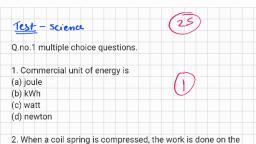Question 1 :
If the power of a motor is $40kW$, at what speed can it raise a load of $20,000N$?
Question 2 :
A particle falls from infinity to the earth. Its velocity on reaching earth of radius R, is:
Question 3 :
Two artificial satellites of masses $m_1 \,\,and \,\,m_2$ aremoving with speeds $v_1\,\, and \,\,v_2$ in orbits of radii $r_1\,\, and\,\,r_2$ respectively. If $r_1 > r_2$ then which of the followingstatements is true.
Question 4 :
The heart takes and discharges $7500$ $l$ of blood in a day. Density of blood $= 1.05 \times 10^3 kg  m^{-3}$. If on an average it takes to a height of $1.6\  m$. Find the power of the heart pump.
Question 5 :
A sphere is suspended by a thread of length $l$ . What minimum horizontal velocity has to be imparted the ball for it to reach the height of the suspension?
Question 6 :
A 10 m long nichrome wire having $80\Omega$ resistance has current carrying capacity of 5 A. This wire can be cut into equal parts and equal parts can be connected in series or parallel. What is the maximum power which can be obtained as heat by the wire from a 200 V mains supply? (in KW)
Question 7 :
A machine gun fires $240$ bullets per minute . If the mass of each bullet is $10\ g$ and the velocity of the bullets is $600\ ms^{-1}$ , the power (in $kW$) of the gun is
Question 8 :
The heart of a man pumps $4000$ cc of blood through the arteries per minute at a pressure of $130$ mm Hg. If the density of mercury is $13.6 \times 10^3 \ kg/m^3$, what is the power of heart ? 
Question 9 :
The power of a pump that takes 10 s to lift 100 kg of water to a tank situated at a height of 20 m is :<br/>
Question 10 :
A man $M_{1}$ of mass 80 kg. runs up a stair case in 15 s. Another man $M_{2}$ also of mass 80 kg. runs up thesame stair case in 20 s. The ratio of the power developed by them will be-<br>
Question 11 :
Imagine a light planet revolving around a very massive star in a circular orbit or radius $R$ with a speed of revolution $T$. If the gravitational force of attraction between the planet and the star is proportional to ${R}^{-5/2}$, then<br>
Question 12 :
A body at rest is moved along a straight line by a machine which delivers constant power. The distance moved by the body in time $t$ is proportional to:
Question 13 :
A constant force of $2.50\mathrm { N }$ accelerates a stationary particle of mass $15\mathrm { g }$ through a displacement of $2.5\mathrm { m }$The average power delivered is
Question 14 :
A person brings a mass of $1 kg$ from infinity to a point A. Initially the mass was at rest but it moves with a speed of $2 m/s$ as it reaches A. The work done by the person on the mass is $3 J.$ The potential of A is.
Question 15 :
If $g$ is the acceleration due to gravity on the earth's surface, the gain in the potential energy of an object of mass $m$ raised from the surface of the earth to a height equal to the radius $R$ of the earth is<br>
Question 16 :
Assertion: Power of a engine depends on mass, angular speed, torque and angular momentum, then the formula of power is not derived with the help of dimensional method.
Reason: In mechanics, if a particularly quantity depends on more than three quantities, then we can not drive the formula of the quantity by the help of dimensional method.
Question 18 :
Helios-B spacecraft had a speed of $71$ km/s when it was $4.3 \times 10^7 km$ from the sun. Its orbit is
Question 19 :
If an electric iron of 1200 W is used for 30 minutes everyday, find electricenergy consumed in the month of April.<br><br>
Question 20 :
A pump takes 20s to lift 50 kg of water to a tankplaced at a height of 10m. What is the power ofthe pump? (g = 10 $m/s^2$)
Question 21 :
A pump is used to lift $500kg$ of water from a depth of $80m$ in $10s$. Calculate the power at which the pump works. (Take $g=10\ ms^{-2}$)<br/>
Question 22 :
The gravitational intensity a region is $10\left ( \hat{i}-\hat{j} \right )N/kg$. The work done by thegravitational force to shift slowly a particle ofmass $1\ Kg$ from point $(1m, 1m)$ to a point $(2m, -2m)$ is<br>
Question 23 :
An electric motor of power 300 W is used todrive the stirrer in a water bath. The work donein one minute, if 60 % of the energy of the motoris utilized to drive the stirrer will be
Question 24 :
The intensity of gravitational field at a point situated at a distance 8000 km from the centre of earth is 6.0 newton /kg. The gravitational potential at that point in newton - meter/kg will be:
Question 25 :
How much horse power (h.p.) is in one kW (Kilowatt) ?
Question 26 :
State whether true or false.<br/>The CGS unit of power is erg $s^{-2}$
Question 28 :
A body of mass '$m$' is raised to a height '$10R$' from the surface of the Earth, where '$R$' is the radius of the Earth. The increase in potential energy is ____ . ($G$ = universal constant of gravitation, $M$ = mass of earth and $g$ = acceleration due to gravity).
Question 29 :
In order to shift a body of mass${ m }$ from a circular orbit of radius${ 3R }$ to a higher orbit of radius${ 5R }$ around the earth, the work done is
Question 30 :
On the surface of earth acceleration due to gravity is g and gravitational potential is V.<br/><table class="wysiwyg-table"><tbody><tr><td>Column-I</td><td>Column-II</td></tr><tr><td>a) At height h = R, value of g</td><td>(p) decreases by a factor 1/4</td></tr><tr><td>(b) At depth h = R/2 value of g</td><td>(q) decreases by a factor 1/2</td></tr><tr><td>(c) At height h = R, of V</td><td>(r) Increases by a factor 11/8</td></tr><tr><td>(d) At depth h = R/2 of V </td><td>(s) Increases by a factor 2<br/>(t) None</td></tr></tbody></table><br/>
Question 31 :
A car of mass $1250$ kg is moving at $30$ m/s. Its engine delivers $30$ kW while resistive force due to surface is $750$N. What max acceleration can be given to the car?
Question 32 :
A pendulum of mass $1\ kg$and length $l = 1\,{\text{m}}$ is released from rest at angle $\theta = \,{60^ \circ }$ . The power delivered by all the forces acting on the bob at the angle $\theta = \,{30^ \circ }$ will be $\left( {g = 10\,{\text{m/}}{{\text{s}}^2}} \right)$.
Question 33 :
Write true or false for the following:<br>The rate of doing work is called power.
Question 34 :
A body of mass $m$ is raised to a height $10R$ from the surface of the earth, where $R$ is the radius of the earth. The increase in potential energy is ($G =$ universal constant of gravitation, $M =$ mass of the earth and $g =$ acceleration due to gravity)
Question 35 :
A boy chews $100 g$ of ice-cream in $5$ minutes. If latent heat of ice $80 cal/gm$, his power is
Question 36 :
A lamp rated $20w$ and an electric iron rated $50w$ are used for $2$ hour everyday. Calculate the total energy consumed in $20 days.$
Question 37 :
An elevator is designed to lift a load of 1000 kg through 6 floors of a building averaging 3.5 m per floor in 6 sec. Power of a elevator neglecting other losses will be:
Question 38 :
Kilowatt is the unit of electrical _______ but kilowatt-hour is the unit of electrical _______.<br/>
Question 39 :
A body slides down a smooth inclined plane of height $h$ and angle of inclination  $30^{0}$ reaching the bottom with a velocity $v$. Without changing the height, if the angle of inclination is doubled, the velocity with which it reaches the bottom of the plane is
Question 40 :
If the rate of electricity is rupee one per unit, then, a 20 h. p. electric motor, having approx. 100% efficiency will require how much cost (Rs.) on 100 hours running to irrigate the field ?
Question 41 :
How much energy does a 2,400 watt machine use in 3 minutes?
Question 42 :
Taking the earth to be a uniform sphere of radius $6400\ \text{km}$ and the value of <i>g</i> at thesurface to be${10 }\ \text{ms}^{ -2 }$, the energy needed to raise a satellite of mass $2000\ \text{kg}$ to a height of $800\ \text{km}$ above the earth's surface and to set it into circular orbit at that altitude wil be
Question 43 :
A girl of mass $40\  kg$ climbs $20$ steps of a staircase, each measuring $20 \ cm$ high in $30\ s$.Calculate the power developed  by the girl.           [Take g = 10 $m/s^2$]
Question 44 :
Heat required to melt $1g$ ice at ${0}^{o}C$ is $80cal$. A man chews $60g$ of ice and melt it in one minute. His power of chewing is
Question 45 :
The change in the value of $g$ at a height $h$ above the surface of earth is the same as at a depth $d$ below the earth. When both $d$ and $h$ are much smaller than the radius of earth, then which one of the following is correct?<br>
Question 46 :
A water pump of power $2kW$ is installed in a home. Then, the amount of water (in litres) it can raise in, one minute to a height of $10m$ is :<br/>[Take $g =10 m/ s^2$] 
Question 47 :
Power spent by a body depends on the time for which it does work.
Question 48 :
A pumping machine pumps a liquid at a rate of $60\ cc$ per minute at a pressure of $1.5$ atmosphere. power of the machine is:
Question 49 :
The power of a motor pump is $2$ kW. How much water per minute the pump can raise to a height of 10 m? (Given $g = 10 m  s^{-2}$)<br/>































